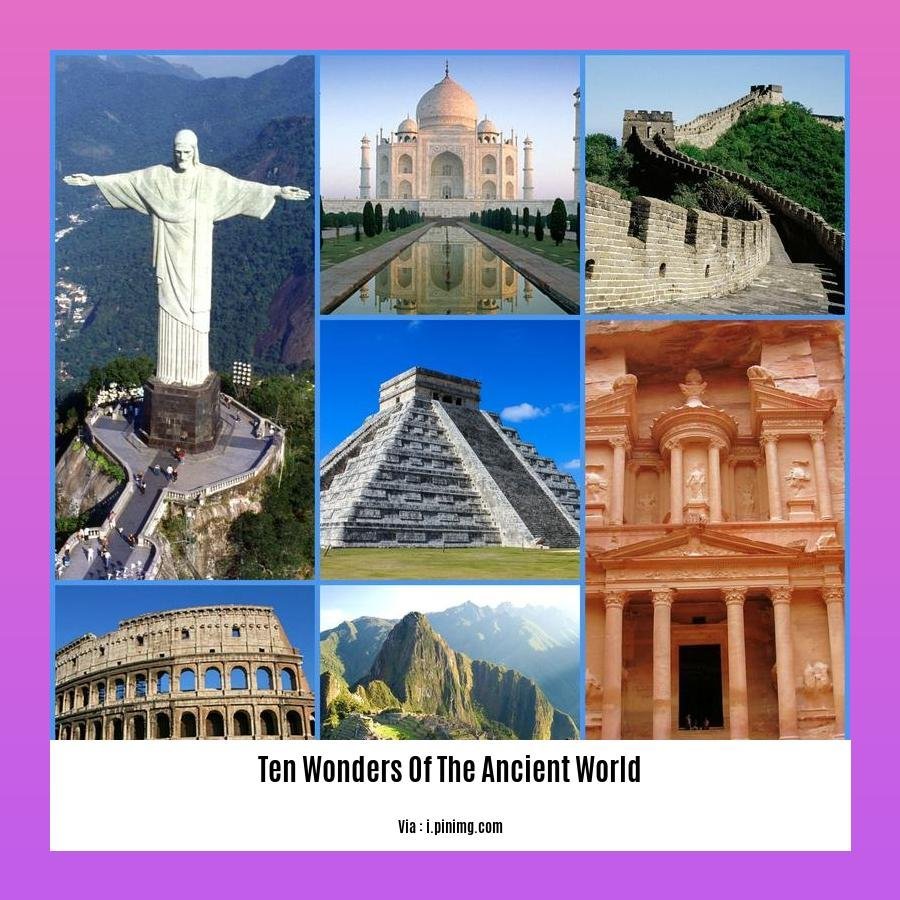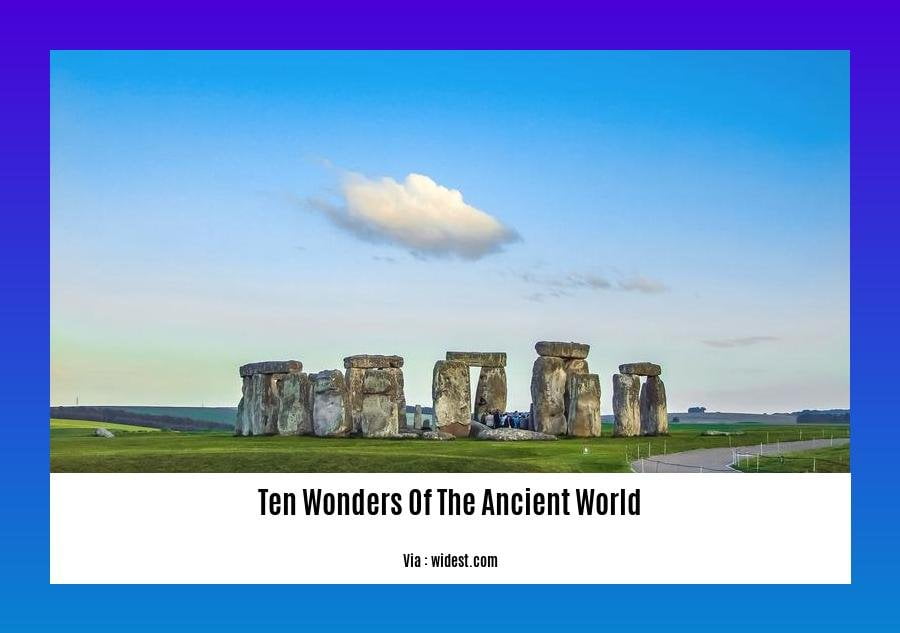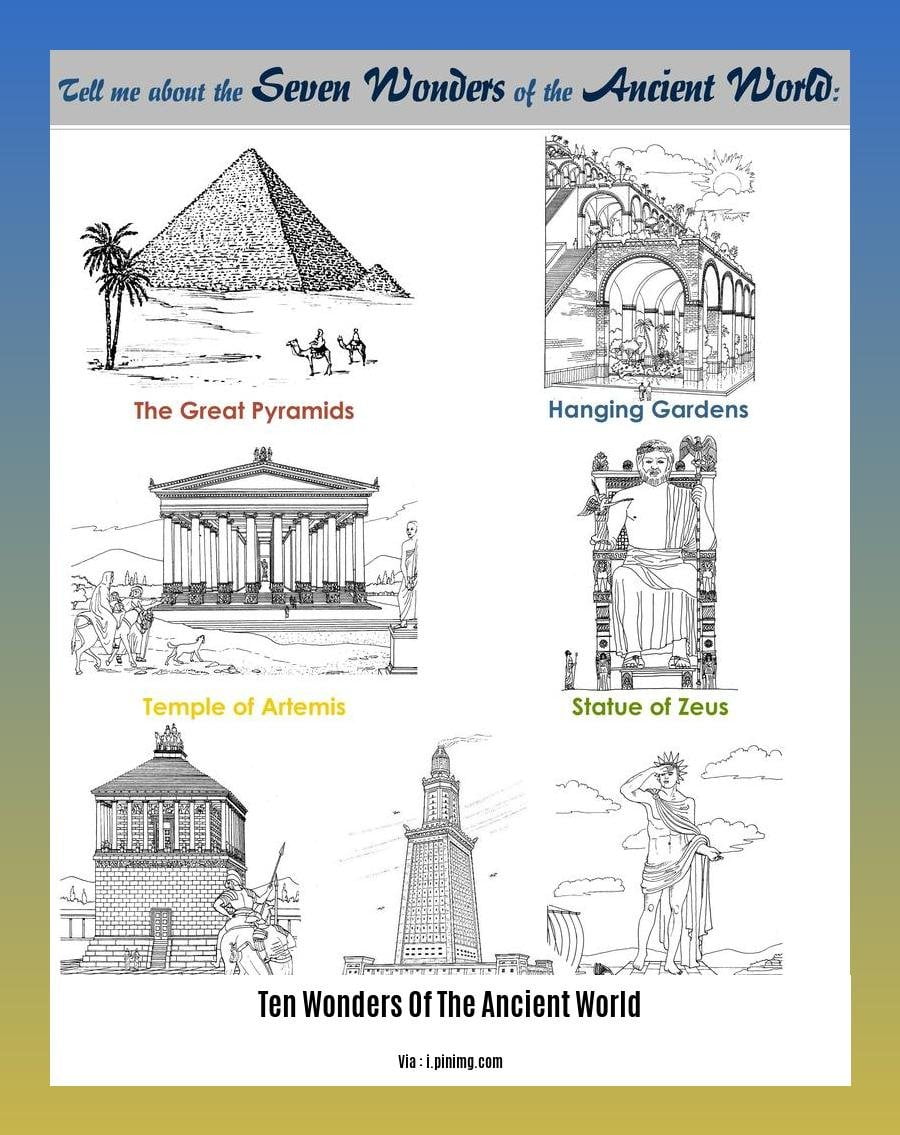In this captivating journey through time, we embark on a quest to uncover the extraordinary wonders that adorned the ancient world. Join us as we unravel the secrets of these iconic landmarks, transcending time to experience the marvels of human ingenuity and creativity that have left an indelible mark on history. Discover the stories embedded within each wonder, tales of architectural prowess, cultural significance, and the enduring spirit of civilizations past in [Journey Through Time: Unveiling the Ten Wonders of the Ancient World].
Key Takeaways:
-
The Great Pyramid of Giza stands tall as the only remaining Wonder of the Ancient World.
-
Stonehenge in England is a mysterious prehistoric monument.
-
The sprawling Great Wall of China is a testament to human ingenuity and determination.
-
Petra, a city carved into sandstone cliffs, showcases the engineering skills of ancient civilizations.
-
The Acropolis of Athens is home to iconic structures like the Parthenon.
-
Banaue Rice Terraces in the Philippines are an impressive example of agricultural ingenuity.
-
Derinkuyu Underground City in Turkey is an ancient city built beneath the earth.
-
The Roman Forum and Colosseum in Rome offer a glimpse into the grandeur of the Roman Empire.
-
The Taj Mahal in India is a splendid architectural marvel built as a tribute to love.
-
The Hanging Gardens of Babylon, Statue of Zeus at Olympia, Temple of Artemis, Mausoleum at Halicarnassus, Colossus of Rhodes, and Lighthouse of Alexandria are wonders that no longer exist but left a lasting legacy.
Ten Wonders of the Ancient World

Prepare to be amazed as we embark on a journey through time, uncovering the stories behind the ten wonders of the ancient world. These awe-inspiring feats of engineering and architecture stand as testaments to the ingenuity and creativity of our ancestors.
The Great Pyramid of Giza: A colossal structure that has stood the test of time, it’s the only surviving wonder of the ancient world. Gaze upon its grandeur and marvel at the precision with which it was constructed.
Stonehenge: A mysterious circle of megaliths in the English countryside, Stonehenge has captivated imaginations for centuries. Its purpose remains a puzzle, fueling theories ranging from a sacred temple to an astronomical observatory.
The Great Wall of China: A symbol of China’s resilience and determination, the Great Wall snakes its way across the country’s northern border. Its sheer size and scale are breathtaking, a testament to the power of human labor.
Petra: Carved into the rose-red rock of Jordan, Petra is an ancient city of breathtaking beauty. Explore its intricate temples, tombs, and amphitheaters, and feel the weight of history in every stone.
The Acropolis of Athens: Perched atop a rocky hill, the Acropolis is home to some of Greece’s most iconic landmarks, including the Parthenon. Its classical architecture and stunning sculptures have inspired artists and architects for centuries.
The Banaue Rice Terraces: A masterpiece of agricultural engineering, the Banaue Rice Terraces are a series of intricately carved terraces that cascade down the mountains of the Philippines. Their beauty is matched only by the ingenuity of the people who built them.
The Derinkuyu Underground City: Hidden beneath the surface of Turkey, Derinkuyu is an underground city that could house up to 20,000 people. Its labyrinthine tunnels, ventilation systems, and water cisterns reveal the incredible resilience and resourcefulness of its ancient inhabitants.
The Roman Forum: The heart of ancient Rome, the Roman Forum was a place of commerce, politics, and religion. Its ruins tell the story of a powerful empire and offer a glimpse into the everyday lives of its citizens.
The Colosseum: A symbol of Rome’s gladiatorial contests, the Colosseum is an awe-inspiring example of Roman engineering. Its massive size and intricate design have made it an enduring symbol of the ancient world.
The Taj Mahal: A monument to love and loss, the Taj Mahal is a stunning mausoleum built by Mughal Emperor Shah Jahan for his beloved wife, Mumtaz Mahal. Its exquisite architecture and delicate details make it one of the world’s most recognizable landmarks.
These ten wonders of the ancient world stand as reminders of the incredible achievements of our ancestors. They invite us to marvel at their ingenuity, creativity, and determination, and to appreciate the rich cultural heritage that they have left behind.
-
Want to get your hands on real ancient Egyptian artifacts? Shop now at our online store! real ancient egyptian artifacts for sale
-
Are you interested in learning about the literary sources used to study ancient Indian history? name the literary sources for study of ancient indian history
-
Eager to discover the Pokémon Ancient Origins card list? pokemon ancient origins card list
The Statue of Zeus at Olympia: Symbol of Divine Power and Athleticism

Imagine standing in awe before a towering figure, carved from ivory and gold, emanating an aura of divine power and athleticism. This was the Statue of Zeus at Olympia, a colossal masterpiece that stood as a symbol of ancient Greece’s religious and cultural heritage.
Zeus: King of the Gods
In Greek mythology, Zeus reigned supreme as the king of the gods, embodying thunder, lightning, and justice. His dominion extended from the heavens to the earth, making him a revered deity across ancient Greece. The Statue of Zeus at Olympia captured this essence, portraying him as a majestic figure seated on an elaborate throne, adorned with intricate symbols of his authority.
Artistic Brilliance and Divine Inspiration
Crafted by the renowned sculptor Phidias around 435 BCE, the Statue of Zeus at Olympia showcased exceptional craftsmanship and artistry. The statue’s colossal dimensions, measuring approximately 12.4 meters (41 feet) in height, filled half the width of the Temple of Zeus, creating an overwhelming presence that commanded attention. The intricate details, from the flowing drapery to the expressive facial features, reflected Phidias’ mastery of the chryselephantine technique, combining ivory and gold to stunning effect.
The Olympic Spirit
The statue’s placement in the Temple of Zeus at Olympia held significant meaning, as Olympia served as the sacred site of the Olympic Games. The games, held every four years, celebrated athleticism, competition, and the pursuit of excellence. The presence of the Statue of Zeus at Olympia symbolized the divine connection between the games and the gods, inspiring athletes and spectators alike.
A Legacy of Wonder
Despite its eventual demise, the Statue of Zeus at Olympia continues to captivate imaginations today. Its grandeur and symbolism have transcended time, inspiring artists, historians, and travelers alike. Though the statue itself is gone, its legacy endures, reminding us of the incredible achievements of ancient Greece and the enduring power of divine inspiration.
Key Takeaways:
-
The Statue of Zeus at Olympia was a colossal ivory and gold statue of the Greek god Zeus, crafted by Phidias around 435 BCE.
-
The statue’s majestic presence symbolized the power and authority of Zeus, the king of the gods.
-
Standing approximately 12.4 meters (41 feet) tall, the statue occupied half the width of the Temple of Zeus at Olympia.
-
Its strategic placement at Olympia reinforced the divine connection between the Olympic Games and the gods.
-
Despite its eventual destruction, the Statue of Zeus at Olympia remains an iconic symbol of ancient Greek artistry and divine inspiration.
Citations:
- Statue of Zeus at Olympia – Wikipedia
- Zeus at Olympia: The Lost Masterpiece of Ancient Greece
The Temple of Artemis at Ephesus: A Monument to the Goddess of Fertility and Hunting
Amidst the ancient ruins of Ephesus, there stands a testament to the ingenuity and artistry of the bygone era. The Temple of Artemis at Ephesus, once regarded as one of the Seven Wonders of the Ancient World, invites you on a journey through time, where history, legend, and divine beauty intertwine.
An Abode of Divinity
Dedicated to the revered goddess Artemis, protector of women, childbirth, and the hunt, the temple’s grandeur symbolized her power and influence. Its colossal scale and intricate adornments spoke volumes about the devotion and skill of the ancient Ephesians. Within its sacred chambers, worshippers paid homage to the goddess, seeking her blessings and guidance.
A Legacy of Destruction and Rebirth
The temple’s story, however, is not without its trials and tribulations. Over the centuries, it faced several devastating blows, from natural calamities to acts of vandalism. Yet, like a phoenix rising from the ashes, the temple underwent numerous reconstructions, each time emerging even more magnificent than before. Its resilience and adaptability stand as a testament to the unwavering faith of the Ephesians in their beloved goddess.
An Architectural Marvel of Antiquity
The temple’s design and construction showcased the architectural prowess of the ancient Greeks. Its massive columns, intricately carved reliefs, and awe-inspiring sculptures harmonized in a symphony of stone. The colossal statue of Artemis, crafted from gold and ivory, stood majestically, radiating divine presence and commanding attention.
A Center of Religious and Cultural Significance
Beyond its religious significance, the temple of Artemis served as a hub of activity in ancient Ephesus. It attracted pilgrims from far and wide, drawn by the allure of the sacred site. Festivals and celebrations honoring Artemis filled the air with music, dance, and joyous revelry. The temple’s presence transformed Ephesus into a thriving center of culture and commerce, a crossroads of civilizations.
A Journey into the Past
As we stand among the ruins of the Temple of Artemis at Ephesus, we can’t help but feel a sense of awe and wonder. This once-magnificent structure, though weathered by time, continues to inspire and fascinate. It’s a legacy of humankind’s enduring quest for connection with the divine, a testament to the power of faith, and a reminder of the architectural wonders that our ancestors were capable of creating.
Key Takeaways:
-
The Temple of Artemis at Ephesus was a grandiose structure dedicated to the goddess of fertility and hunting.
-
Its construction spanned centuries, with multiple rebuildings following devastating events.
-
The temple’s architectural design showcased the skills and artistry of ancient Greek builders.
-
It served as a central site for religious ceremonies, festivals, and cultural gatherings.
-
Despite its destruction, the temple’s legacy continues to captivate and inspire.
Source:
Britannica – Temple of Artemis
World History – Temple of Artemis at Ephesus
The Mausoleum at Halicarnassus: A Majestic Tomb of Love and Mourning
Picture this: A grand edifice rising above the ancient city of Halicarnassus, its white marble gleaming under the Mediterranean sun. This remarkable structure, The Mausoleum at Halicarnassus, stands as a testament to the enduring power of love and the architectural prowess of the ancient world.
Carved into the landscape in 353 BC, this colossal tomb was commissioned by Mausolus, a satrap in the Achaemenid Empire, as a final resting place for his beloved wife, Artemisia II of Caria. Their love story, etched in stone, has captivated imaginations for centuries.
The mausoleum’s grandeur is a symphony of architectural brilliance. Its stepped roof, adorned with intricate sculptures, reaches towards the heavens. Thirty-six Ionic columns encircle the structure, their fluted shafts adding an air of elegance and majesty.
Inside, the tomb was a treasure trove of artistic wonders, filled with statues, reliefs, and mosaics depicting scenes from Greek mythology and the lives of Mausolus and Artemisia. This opulent display of wealth and power pays tribute to the couple’s extraordinary bond.
Sadly, the ravages of time and natural disasters have reduced this magnificent monument to ruins. But even in its fragmented state, The Mausoleum at Halicarnassus continues to inspire awe and wonder. Its remnants, now housed in museums around the world, serve as a reminder of the enduring legacy of love and human ambition.
Key Takeaways:
-
The Mausoleum at Halicarnassus, commissioned by Mausolus for his beloved wife Artemisia II of Caria, stands as a testament to their enduring love.
-
This colossal tomb, built between 353 and 350 BC, showcased the architectural prowess of the ancient world, featuring a stepped roof, Ionic columns, and intricate sculptures.
-
The mausoleum’s interior was adorned with statues, reliefs, and mosaics, offering glimpses into Greek mythology and the lives of Mausolus and Artemisia.
-
Despite its destruction by earthquakes and the passage of time, The Mausoleum at Halicarnassus remains an enduring symbol of love, mourning, and architectural brilliance.
Citations:
- https://www.worldhistory.org/Mausoleum_at_Halicarnassus/
FAQ
Q1: Which ancient wonder is the only one still standing today?
A1: The Great Pyramid of Giza, located in Egypt, is the only remaining wonder of the ancient world that has survived to the present day.
Q2: What are the materials used in the construction of the Statue of Zeus at Olympia?
A2: The Statue of Zeus at Olympia was made from ivory and gold panels attached to a wooden substructure, employing the chryselephantine technique.
Q3: Why was the Temple of Artemis considered one of the Seven Wonders of the Ancient World?
A3: The Temple of Artemis was renowned for its grand scale, exquisite craftsmanship, and intricate sculptures, showcasing the architectural and artistic skills of the ancient Greeks.
Q4: What is the story behind the Mausoleum at Halicarnassus, and who was it built for?
A4: The Mausoleum at Halicarnassus was built as a tomb for Mausolus, a satrap (governor) in the Achaemenid Empire, and his sister-wife Artemisia II of Caria. It was designed by Greek architects and featured elaborate sculptures and reliefs.
Q5: How did the Hanging Gardens of Babylon contribute to the agricultural practices of ancient Mesopotamia?
A5: The Hanging Gardens of Babylon, though not physically confirmed, are often described as a marvel of engineering and horticulture. They allowed for the cultivation of various plants and trees on multiple levels, maximizing agricultural production in a limited space.
- Unveiling the Enigma: Mansoureh Khojasteh Bagherzadeh’s Public Appearances & Private Life in Iran - July 18, 2025
- Unveiling the Mystery: Mansoureh Khojasteh Bagherzadeh’s Husband: A Rare Glimpse into a Private Life - July 18, 2025
- Unveiling Masoud Khamenei’s Mother: Power, Influence, and Iran’s Future - July 18, 2025
















